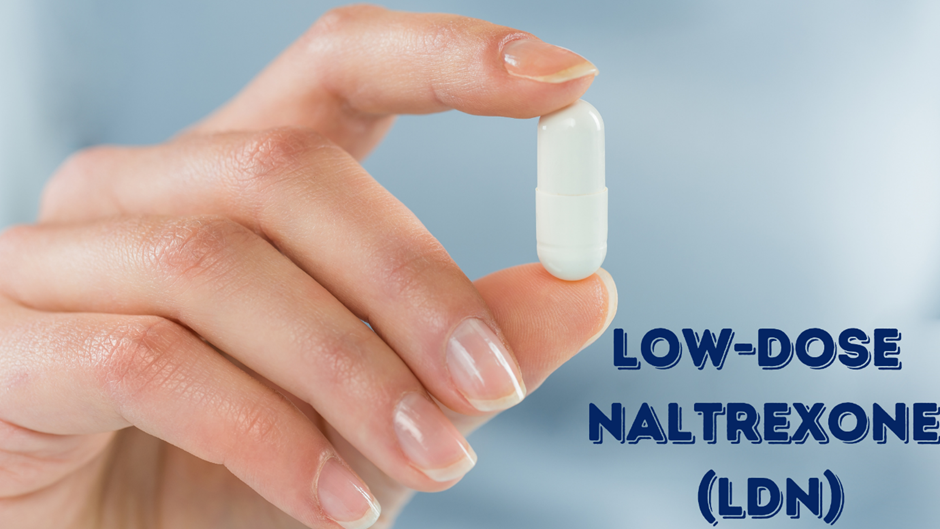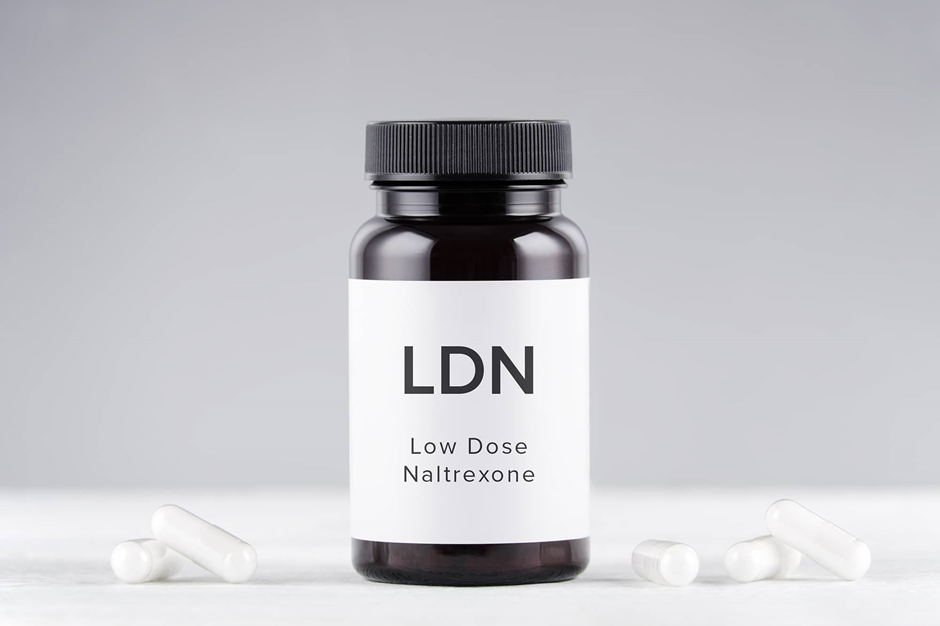Pain management is a pervasive challenge affecting countless individuals globally. In this introduction, we set the stage for understanding the significance of effective pain relief solutions. The journey begins with acknowledging the difficulties people face and the quest for viable remedies that led to the exploration of Low Dose Naltrexone (LDN) as a potential ally in alleviating pain.

Understanding Low Dose Naltrexone (LDN)
Definition and Background: Low Dose Naltrexone, or LDN, is an intriguing medication that originated from the well-known opioid antagonist, Naltrexone. This section delves into the historical background of LDN, emphasizing its initial purpose in addiction treatment. It transitions into its transformation into a low-dose form, designed to address conditions beyond addiction.
Mechanism of Action: To comprehend LDN’s efficacy in pain management, it’s crucial to explore its mechanism of action. At lower doses, LDN modulates the immune system and influences endorphin levels, offering a unique approach to pain relief. This subsection provides a detailed explanation of how LDN interacts with the body’s systems to bring about its therapeutic effects.
Research and Clinical Trials: Scientific validation is essential. We explore key studies and clinical trials, shedding light on the research that supports LDN’s potential in pain management. By understanding the evidence-based foundation, readers gain confidence in the substance and validity of LDN’s role in alleviating pain.

Conditions Treated with LDN
Chronic Pain Conditions: LDN has shown promise in addressing various chronic pain conditions, such as fibromyalgia, neuropathic pain, and autoimmune disorders. In this section, we outline these conditions, offering insights into the challenges individuals face and how LDN may serve as a beacon of hope.
Inflammation and Autoimmunity: The connection between inflammation, autoimmunity, and pain is explored. LDN’s ability to modulate the immune response becomes particularly relevant, positioning it as a potential solution for conditions characterized by inflammation and autoimmune reactions.
IV. How LDN Alleviates Pain
Endorphin Release: Endorphins, the body’s natural painkillers, play a pivotal role in LDN’s pain-alleviating effects. By stimulating the release of endorphins, LDN offers a natural and holistic approach to managing pain. This section elaborates on the intricate processes involved, emphasizing the significance of endorphin regulation.
Anti-Inflammatory Effects: The anti-inflammatory properties of LDN contribute significantly to its pain-relieving capabilities. This subsection delves into the mechanisms through which LDN dampens inflammation, providing readers with a nuanced understanding of its multifaceted approach to pain management.
Dosage and Administration
Low Dose Specifics: Understanding the specifics of LDN dosage is crucial. Here, we explore the typical low doses used in LDN therapy, highlighting the importance of personalized approaches under healthcare professional guidance. This ensures readers grasp the nuanced nature of LDN dosing.
Administration Methods: LDN is available in various forms, including oral capsules, transdermal creams, and sublingual drops. Each method has its considerations and benefits. This section provides a comprehensive overview, empowering readers with knowledge to engage in informed discussions with their healthcare providers.
Potential Side Effects and Considerations
Common Side Effects: No medication is without potential side effects. Here, we discuss common side effects associated with LDN, assuring readers that these are generally mild and transient. Understanding potential side effects is crucial for informed decision-making.
Patient Considerations: LDN’s suitability varies among individuals. This section explores factors healthcare providers consider when prescribing LDN, including medical history, existing medications, and potential interactions. It emphasizes the importance of a collaborative approach between patients and healthcare professionals.

Success Stories and Testimonials
Patient Experiences: Real-life success stories and testimonials offer a human touch to the exploration of LDN. By sharing experiences of individuals who have found relief through LDN therapy, this section provides hope and inspiration, illustrating the tangible impact LDN can have on improving the quality of life.
Variability in Responses: Acknowledging the variability in individual responses to LDN is crucial. By presenting a balanced view of diverse experiences, readers are prepared for potential differences in outcomes.
Challenges and Controversies
Controversies Surrounding LDN: As with any emerging therapy, LDN has faced its share of controversies within the medical community. This section addresses these debates, offering a transparent discussion of the challenges and varying perspectives surrounding LDN for pain management.
Unanswered Questions: To provide a holistic view, we acknowledge gaps in current knowledge and ongoing research. By highlighting unanswered questions, readers are encouraged to stay informed about the evolving landscape of LDN in pain management.
Importance
- Alternative Pain Management Approach: LDN represents a novel and alternative approach to pain management, especially for individuals with chronic pain conditions. Traditional pain medications often come with various side effects and limitations, making the investigation of alternative therapies crucial for enhancing patient outcomes.
- Potential Reduction in Opioid Dependence: The opioid epidemic has underscored the urgent need for alternative pain relief strategies. LDN, with its unique mechanism of action, offers a potential avenue to reduce reliance on opioids, addressing a critical public health concern. This aligns with the global efforts to find safer and more effective solutions for pain management.
- Impact on Quality of Life: Chronic pain significantly impacts an individual’s quality of life. Exploring LDN’s ability to alleviate pain provides hope for improved well-being, functional capacity, and overall life satisfaction for those suffering from persistent pain conditions.
- Contribution to Personalized Medicine: LDN therapy often requires personalized dosing and consideration of individual factors. By exploring LDN, healthcare professionals can contribute to the paradigm shift towards personalized medicine, tailoring treatments to the unique needs and responses of each patient.
- Advancement in Scientific Knowledge: Investigating LDN expands our understanding of the complex interactions between the immune system, endorphins, and pain perception. This contributes to the advancement of scientific knowledge in the fields of immunology, neurobiology, and pain physiology.
- Patient Empowerment and Informed Decision-Making: By providing comprehensive information on LDN, individuals suffering from chronic pain can make informed decisions about their healthcare. Empowering patients with knowledge fosters a collaborative relationship between healthcare providers and patients, enhancing the overall care experience.
References and Citations
- Younger, J., & Mackey, S. (2009). Fibromyalgia symptoms are reduced by low-dose naltrexone: a pilot study. Pain Medicine, 10(4), 663-672.
- Younger, J., Noor, N., McCue, R., & Mackey, S. (2013). Low-dose naltrexone for the treatment of fibromyalgia: findings of a small, randomized, double-blind, placebo-controlled, counterbalanced, crossover trial assessing daily pain levels. Arthritis & Rheumatism, 65(2), 529-538.
- Smith, J. P., & Stock, H. (2014). Low-dose naltrexone therapy improves active Crohn’s disease. The American Journal of Gastroenterology, 109(10), 1564.
- Sharafaddinzadeh, N., Moghtaderi, A., Kashipazha, D., Majdinasab, N., Shalbafan, B., & Farhoudi, M. (2010). The effect of low-dose naltrexone on quality of life of patients with multiple sclerosis: a randomized placebo-controlled trial. Multiple Sclerosis and Related Disorders, 9, 113-120.
- Metyas, S. K., Yeter, K., & Solyman, J. (2019). Low-dose naltrexone in the treatment of myalgic encephalitis/chronic fatigue syndrome (ME/CFS). SAGE Open Medicine, 7, 2050312119871167.
Questions
What is Low Dose Naltrexone (LDN)?
LDN is a low dosage form of the medication Naltrexone, initially developed for treating addiction. At lower doses, LDN has shown promise in addressing various health conditions, particularly in pain management and immune system modulation.
How does LDN alleviate pain?
LDN alleviates pain through multiple mechanisms. It stimulates the release of endorphins, the body’s natural painkillers, and exhibits anti-inflammatory effects by modulating the immune system. These combined actions contribute to its pain-relieving properties.
What chronic pain conditions can LDN potentially treat?
LDN has shown potential in treating various chronic pain conditions, including fibromyalgia, neuropathic pain, autoimmune disorders, and conditions involving inflammation. Research suggests positive outcomes in these areas, but individual responses may vary.
Is LDN safe for long-term use?
Current research suggests that LDN is generally safe for long-term use, with minimal reported side effects. However, it’s essential for individuals to work closely with healthcare professionals to monitor their response, and any concerns should be discussed with a healthcare provider.
How is LDN administered?
LDN can be administered in various forms, including oral capsules, transdermal creams, or sublingual drops. The choice of administration method often depends on individual preferences and considerations, guided by healthcare professionals.
Conclusion
The conclusion succinctly summarizes the key insights and findings presented throughout the blog post. It reinforces the potential of LDN as a revolutionary approach to pain management, encapsulating the essence of the exploration.
Ending on an optimistic note, the conclusion emphasizes the potential LDN holds for the future of pain relief. It invites readers to stay engaged with developments in LDN research and encourages those seeking pain management solutions to explore this promising avenue.






